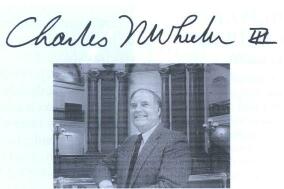 |
Home | Search | Browse | About IPO | Staff | Links |
 |
Home | Search | Browse | About IPO | Staff | Links |
|
POLITICS

Legislative races by Charles N. Wheeler III
William Shakespeare certainly was not thinking of Illinois legislative politics when he penned his Scottish thane's bleak appraisal of the ultimate folly of life itself. Still, as one looks back on the 2000 elections for the Illinois General Assembly, Macbeth's lament readily comes to mind. The campaign saw record amounts of money spent, a barrage of attack ads and a numbing flow of direct mail, all targeted at a relative handful of districts that partisan strategists expected would determine which party would control the legislature for the all-important redistricting year. And when all was said and done, nothing changed. Republicans keep their 32-27 Senate edge; Democrats still will have a 62-56 advantage in the House. There will be some new faces in January, of course; a handful of incumbents were dumped in their parties' primaries, and several others opted not to seek new terms, either in quest of other offices or of retirement.
Perhaps it's not surprising that no district changed political hands last month. During five elections under the 1991 redistricting plan, only four of 59 Senate districts and 18 of 118 House districts switched allegiance from the party they selected in 1992, including 10 the GOP won in 1994 and have defended successfully three times since. Party leaders certainly spared little expense in contesting so-called target districts. The election saw two races become the first to break the million-dollar spending mark for House seats, and final reports might push a couple of others past $1 million, too. In the two top-spending contests, Democratic Reps. Dan Reitz of Steeleville and Jim Fowler of Harrisburg won by larger margins than they had two years ago. So did every other targeted House Democrat. Republican incumbents on the Democrats' hit list also survived, but in most cases by narrower margins, including Rep. Renee Kosel of New Lenox, unofficially a 129-vote winner. In the Senate, the closest contest saw Sen. Wendell Jones, a Palatine Republican, edge Democrat Sue Walton of Rolling Meadows in that chamber's eighth million-dollar race. Two other Senate targets — Republican Christine Radogno of LaGrange and Democrat Terry Link of Vernon Hills — won more handily than in 1996, while a third, GOP Sen. Patrick O'Malley of Palos Park, saw his edge shaved slightly, though he still won by about 11,000 votes. Although the quo remained status for the legislative branch in Illinois, the results of Election 2000 challenged the conventional wisdom elsewhere. In a break from tradition, Rock Island attorney Tom Kilbride bested state Sen. Carl E. Hawkinson, a Galesburg Republican, for the Illinois Supreme Court spot being vacated by Justice James D. Heiple. Kilbride thus becomes the first Democrat elected to the high court from the 3rd District, a 21-county swath across north central Illinois. The contest also was the first to top $1 million in general election spending for the high court, shattering the old record by more than $450,000. More surprising, perhaps, was the lopsided victory Democratic presidential candidate Al Gore rang up in Illinois over his GOP rival, Texas Gov. George W. Bush. Unofficial results gave the vice president a 565,000-vote lead, good for a 54-43 edge in a state that some national pundits and preelection polls suggested might be more competitive. In missing the mark, the soothsayers and pulsetakers likely failed to appreciate fully the personal stake the Illinois contest held for Chicago Mayor Richard M. Daley, whose brother William led the Gore effort nationally. Surely not even the most ardent partisan could have expected Gore to pad his 600,000-vote bulge coming out of the city by carrying the suburbs. Gore beat Bush by some 140,000 votes in suburban Cook County, offsetting Bush's roughly 100,000 collar county margin, so that the vice president 42 December 2000 Illinois Issues www.uis.edu/~ilissues carried the suburbs — once regarded as a bastion of GOP strength — by more than 40,000 votes. In fact, of the almost 2.6 million votes Gore tallied in Illinois, 37 percent came from the suburbs, greater than the share from either Chicago (30 percent) or the other 96 counties (33 percent).
Almost equal amounts of Bush's 2 million votes (46 percent each) came from downstate and the suburbs, although the Texas governor won a few thousand votes more outside the six-county Chicago area. Only about 8 percent of his total count, roughly 164,000 votes, came from the city, where he lost all 50 wards, some in black neighborhoods by margins of 50-or 60-1. In the scramble to explain what happened in the "solidly Republican" suburbs, several hypotheses emerged. Senate President James "Pate" Philip of Wood Dale speculated Gore may have frightened senior citizens away from Bush with misleading ads on Social Security and Medicare. Others wondered whether GOP leaders like Philip, the DuPage County Republican chairman, might have become too lackadaisical about evangelizing new residents, simply assuming that a penchant for voting Republican comes with the mortgage papers. Some noted growing suburban diversity, with more African-American and Hispanic residents, traditionally Democratic voters. The answer may be simply that the Texas governor's positions on gun control, the environment, abortion rights and other issues were too conservative for many of the almost 500,000 collar county residents who chose Gore. After all, Gov. George H. Ryan won 68 percent of the collar county vote two years ago in part by portraying his Democratic opponent as an extremist on issues like gun owners' rights and clean air legislation. Whatever the reason, the results show that suburban Chicago is no longer exclusive GOP turf, adding another wrinkle to next year's redistricting puzzle. Charles N. Wheeler III is director of the Public Affairs Reporting program at the University of Illinois at Springfield. www.uis.edu/~ilissues Illinois Issues December 2000 43 |
|
|